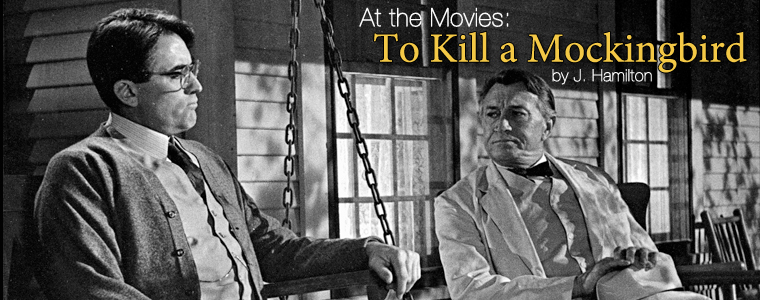Of Men and Mockingbirds
by J. Hamilton
I saw To Kill a Mockingbird at the Waco Theater in Waco, Texas, in January, 1963. Clueless at the time — I hadn’t heard of the book by Harper Lee, and didn’t know a thing about the movie, but I accompanied the boys from Kokernot (my dormitory at Baylor University). As a group, we ritually attended a movie every Friday night.
We filled a center-section-row close to the front. I sat near Glen Pearson, a sophomore from Hattiesburg, Mississippi, because he would make the wittiest comments. The credits rolled: a child’s hands opening a cigar box while tunelessly humming — viewers only see the hands, the contents of the box, and the names of the people who made the movie. I only recognized the name of Gregory Peck.
Glen did say something witty about the contents of the box: carved soap dolls of a boy and a girl, a broken pocket watch, used crayons, a school medal, and an athletic whistle. We laughed, but I don’t remember what he said. To Kill a Mockingbird took over. We watched, entranced.
It’s a story about three children. We see the movie from their point of view. Scout (Mary Badham) — the little girl and the protagonist/adult narrator who tells us it is the summer of 1932 (an era when Downtown was available to any child willing to walk a few blocks); Jem (Phillip Alford), her four-years-older brother; and a summer friend the same age as Scout called Dill (John Megna) who comes to Maycomb County, Alabama in the summer to live with his aunts.
The children play in the yard of their house, and obsess about their neighbor Boo Radley (Robert Duvall), the neighborhood boogeyman. They challenge one another, harass the Radley house, and worship their father, Atticus Finch (Gregory Peck), a town lawyer.
Not promising fare for a bunch of college men from Kokernot Hall. If you have seen the movie, you know better. I’ve seen the movie — I know better. What is To Kill a Mockingbird about? Race? Rape? The poverty experienced in the South during the Depression? All those figure in, but that’s not what it is about. No, it’s about love — love and protection.
The dramatic spine of the story involves an interracial rape. Atticus defends Tom Robinson (Brock Peters), the accused rapist. His accusers are Mayella Ewell (Collin Wilcox) and her father, Bob Ewell (James K. Anderson) — all three character actors play their roles so convincingly they almost steal the movie.
Mayella, at the end of her testimony, delivers the strongest speech in the movie: “I got somethin’ to say. And then I ain’t gonna say no more. He took advantage of me. An’ if you fine, fancy gentlemen ain’t gonna do nothin’ about it, then you’re just a bunch of lousy, yella, stinkin’ cowards, the – the whole bunch of ya, and your fancy airs don’t come to nothin’. Your Ma’am’in’ and your Miss Mayellarin’ – it don’t come to nothin’, Mr. Finch, not…no.”
Atticus proves the rape charge impossible, but the jury finds Tom Robinson guilty anyway. Robinson is killed by his guards that night. The rape story is over — but it’s not.
At the beginning of the movie we know that two males love Scout. At the end of the movie we find out it’s three.
Jem loves her as a brother should. He corrects her, lectures her, gets her out of trouble at school, spends his days playing with her and Dill, and allows her to take part in his Radley house adventures.
Atticus loves Scout. He advises her toward adulthood. He takes care of her needs. He gently helps her through her crises.
And Boo Radley loves Scout. It takes a while for that to sink in. The crazy-man with the mind of a child had studied them from the windows of his house, just as the children had studied the house. He had left them the contents of the cigar box, shown in the credits, as gifts delivered one at a time in the hollow of a tree. He shadowed them at night to make sure they were safe, and killed Bob Ewell (the real rapist) when he tried to kill Scout.
The shock of this realization overwhelmed us — I have spent the intervening years imagining Boo pressed up against the front wall of his house while he studied the children through the angle of his front window.
It’s about love.
The boys from Kokernot returned to the dorm in silence. Glen tried to begin a discussion of Aristotle’s concept of catharsis. No one responded. We were too cathartically stunned.
The movie represents a gathering of fortunate genius. Many of the people whose names I didn’t know went on to have great careers working on other projects: Horton Foote, the screenwriter; Elmer Bernstein, the composer; Alan J. Pakula, the producer; Robert Mulligan, the director — but none of them ever worked on a greater film. The role of Atticus remained Peck’s signature performance for the rest of his life.
The film can be watched again and again without cloying. I watch it at least once a year, and this year I get to see it on the big screen once more.
On Thursday, November 15, Turner Classic Movies will show To Kill a Mockingbird at a theater near you. I can’t think of a better way to spend a Thursday night.




Movie stills courtesy of TCM Events.
To find tickets for a theater near you, click HERE.












